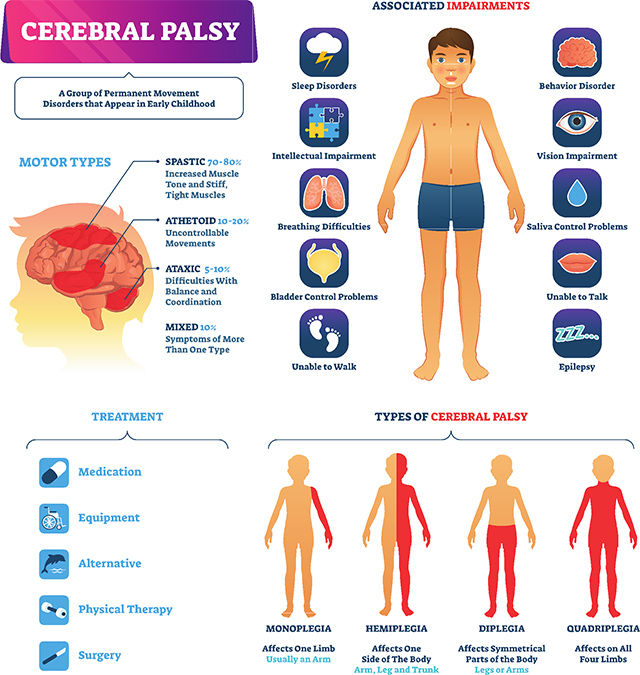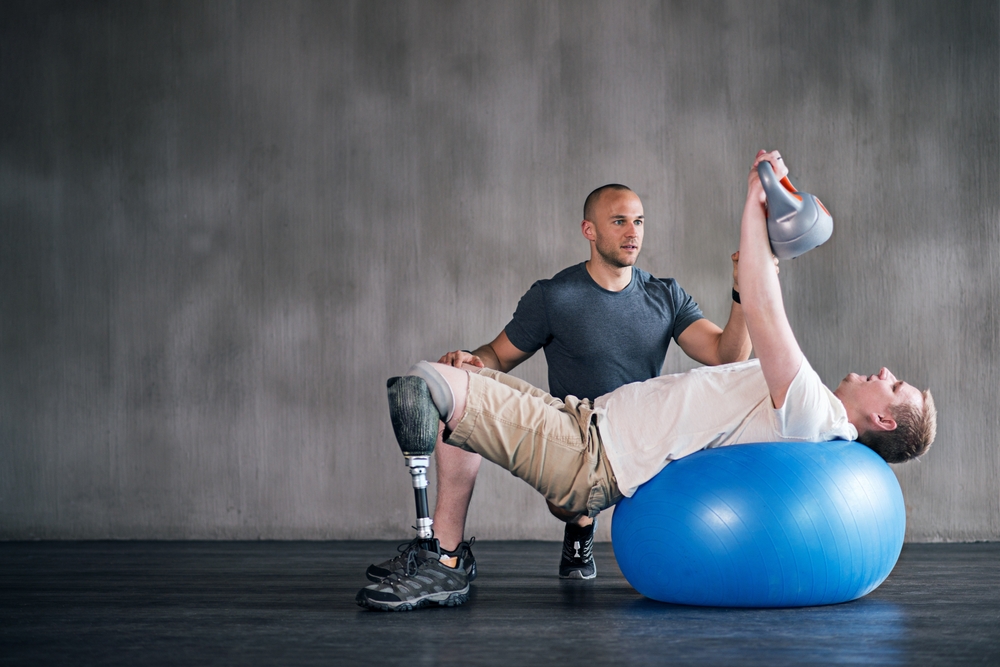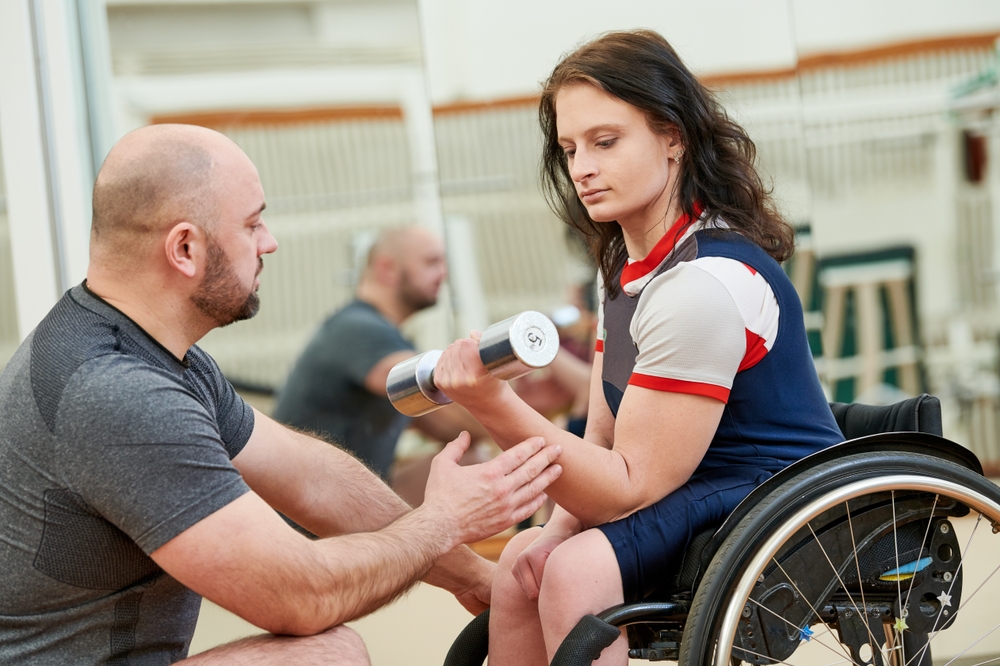Make an Appointment
Cerebral palsy is caused by damage to brain tissue that can affect a wide variety of functions. Although you may not associate cerebral palsy with physiotherapy, a physio can offer a lot of relief to people suffering from symptoms of cerebral palsy.
Here, we’re going over what cerebral palsy is, along with its symptoms and causes, and how physiotherapy can play a role in the management of cerebral palsy.
What is cerebral palsy?
Cerebral palsy presents a wide variety of symptoms. The term refers to any non-progressive disability resulting from damage to the brain tissue during pregnancy, birth, or early childhood. Since the brain’s development was disrupted, it can cause a consequent disruption of nerve signals that are meant to flow to the rest of the body.
People with cerebral palsy often have trouble with motor skills, posture, and coordination but it can also affect breathing, bladder and bowel control, eating, and talking. In extreme cases, cerebral palsy might also cause issues with sight and hearing as well as learning disabilities.
As you can see, cerebral palsy is extremely detrimental to one’s well-being since it can affect so much of the body. Again, everyone with cerebral palsy will present different symptoms since the term is an umbrella for any kind of disability resulting from brain damage.

Cerebral Palsy Causes
In most cases, the specific cause of cerebral palsy is unknown. More generally, cerebral palsy is caused by damage to the brain’s tissue during early development - either before you were born, during birth, or during infancy. Some reasons a child’s brain might become damaged include:
- Infections during pregnancy
- Stroke either while in the womb or during infancy
- Jaundice that was left untreated
- Genetic disorders
- Mother’s medical problems during pregnancy
- Problems during birth (although rare)
- Lead poisoning
- Bacterial meningitis
- Poor blood flow to the brain
- Shaken baby syndrome
- Head injuries
Most of these causes are unavoidable and since they occur in such early stages of life, the brain doesn’t get the chance to develop in a healthy way. Because of this, cerebral palsy has drastic symptoms.
Symptoms of Cerebral Palsy
As previously mentioned, cerebral palsy has a huge range of symptoms depending on which part of the brain has been damaged.
There are three types of cerebral palsy that present themselves in different ways.
- Spastic cerebral palsy causes stiffness and difficulty with movement
- Dyskinetic (athetoid) cerebral palsy causes uncontrolled movements
- Ataxic cerebral palsy causes issues with balance and depth perception
In addition to these muscle-related symptoms, other issues caused by cerebral palsy include:
- Visual impairment
- Hearing impairment
- Food aspiration (food and drink moving into the lungs)
- Gastroesophageal reflux
- Speech and communication problems
- Drooling
- Tooth decay
- Sleep disorders
- Osteoporosis
- Behavioural problems
- Learning disabilities
- Seizures
There is no known cure for cerebral palsy but there are ways to treat some of these symptoms to make them less overwhelming for the patient and their caretakers which we’ll go over more down below.
Physiotherapy Management of Cerebral Palsy
The sooner someone with cerebral palsy begins working with a physiotherapist, the better. Depending on the symptoms and when they arise, it’s possible to take advantage of physiotherapy either before or quite soon after an official diagnosis.
Here are the different ways Physio Inq can help people with cerebral palsy:
- Physiotherapy for children with cerebral palsy
- Physiotherapy for adults with cerebral palsy
- Occupational therapy to manage cerebral palsy
- Speech and language therapy for cerebral palsy
Physiotherapy for Children with Cerebral Palsy
The primary aim of paediatric physiotherapy for cerebral palsy in children is to increase their mobility while promoting physical development. With regular treatment, physiotherapy can help kids with cerebral palsy meet important developments milestones like sitting, crawling, and walking.
The goal of physiotherapy for children with cerebral palsy include:
- Improved muscular strength and activation
- Fewer muscle spasms and more flexibility with stretching programs and splinting techniques
- Physical development programs through playing and practicing everyday activities
Physiotherapy for Adults with Cerebral Palsy
Although cerebral palsy is caused during pregnancy, birth, and infancy, there are many cases of adults still living with cerebral palsy who can benefit from physiotherapy as well. The goals of treating adults with cerebral palsy remain the same but the exercises will change depending on the person’s age and symptoms.
Physiotherapy treatments for cerebral palsy in adults include:
- Strengthening and mobilising exercises to improve muscular strength and tone
- Realignment strategies
- Seating and mobility aids to improve balance and posture
- Sensory stimulation
- Stretching programs to improve flexibility while reducing muscle spasms, stiffness, and pain
- Gait training to improve balance and reduce the risk of falls
- Education to improve independence and overall quality of life
Occupational Therapy to Manage Cerebral Palsy
In addition to physiotherapy services, Physio Inq also offers occupational therapy which helps patients at work, at school, in the home, and during leisure activities.
Occupational therapy for cerebral palsy includes assistance with:
- Ability to function in individual and group activities
- Establishing a need for equipment, adaptations, or further rehabilitation
- Splinting and exercise programs
- Advice and education about adapting and managing changes in the physical and social environment
- Equipment to aid in transfers and mobility
Other Useful Resources
Occupational Therapy role in physical disabilities & the NDIS
Speech and Language Therapy for Cerebral Palsy
Since cerebral palsy often affects so much more than muscle function throughout the body, you may also require working with a speech pathologist to assist with speech and language therapy. Difficulties with verbal, non-verbal, and written communication can all benefit from working with a Physio Inq speech pathologist.
A speech pathologist can help someone with cerebral by addresing the following:
- Communication aids
- Motor skills of the mouth and tongue
- Eating and swallowing
- Reading comprehension
- Support for caretakers and family
Other Useful Resources
How to know if speech therapy for a 3 year old is necessary?
Cerebral palsy is an incredibly debilitating disorder and those who suffer from it go through a lot. However, with the help of our experts at Physio Inq, people with cerebral palsy can live fulfilling and meaningful lives full of independence and strength.
If you or your child is struggling with the symptoms of cerebral palsy, we’d love to hear from you. We’ll set up an appointment with the appropriate therapist, whether if it’s one of our mobile & home physio, OT, or speech pathologist, to help give you and your family empowering tools and advice. Call us today!
Date Published: Monday, March 9, 2020
Locate a Paediatric Physiotherapy
Service Near me
Get the experience & convinence you deserve to support your or a loved one's allied health needs.
Our Paediatric Physiotherapy team are currently serving & taking appointments in the following states and regions in Australia:
Need to get into direct contact with ur Client Services team? We're all ears. Call our team directly on 1300 731 733






